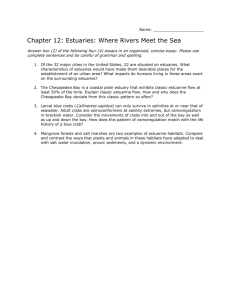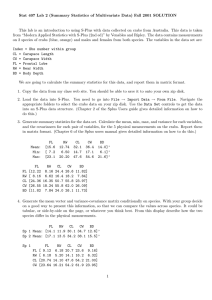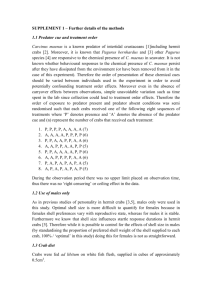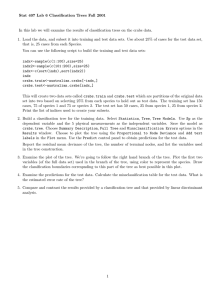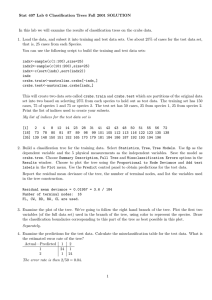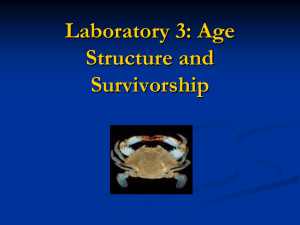Status of the European Green Crab in Oregon Estuaries Fall 2003
advertisement
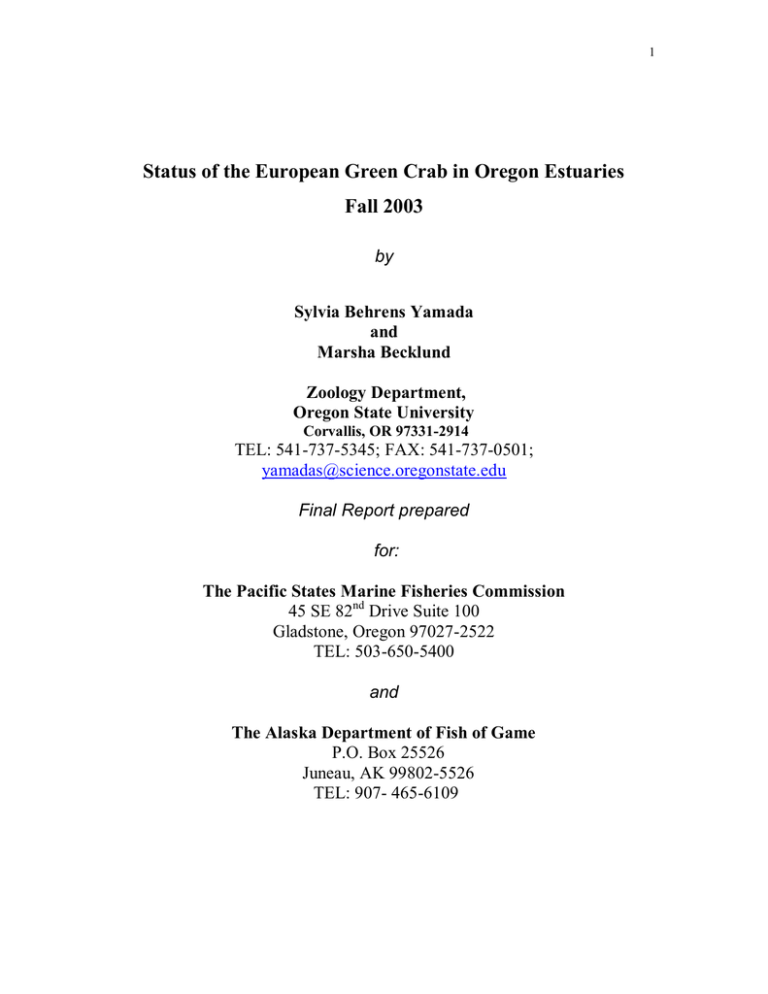
1 Status of the European Green Crab in Oregon Estuaries Fall 2003 by Sylvia Behrens Yamada and Marsha Becklund Zoology Department, Oregon State University Corvallis, OR 97331-2914 TEL: 541-737-5345; FAX: 541-737-0501; yamadas@science.oregonstate.edu Final Report prepared for: The Pacific States Marine Fisheries Commission 45 SE 82nd Drive Suite 100 Gladstone, Oregon 97027-2522 TEL: 503-650-5400 and The Alaska Department of Fish of Game P.O. Box 25526 Juneau, AK 99802-5526 TEL: 907- 465-6109 2 Executive Summary The invasion of Pacific Northwest estuaries by the European green crab, Carcinus maenas, caused much initial alarm. Following the strong El Niño of 1997-98, young green crabs appeared in estuaries along the coasts of Oregon, Washington, and as far north as Port Eliza on the west coast of Vancouver Island, British Columbia. Unusually strong northward-moving coastal currents (up to 50 km/day from September 1997 to April 1998) must have transported green crab larvae from more established source populations in California to the Northwest. Coastal transport events have been much weaker in recent years. Crabs from the 1997/98 colonizing year class were still in the population during the early summer of 2003. Males from that year class ranged from 86-98 mm in carapace width. By the fall we did not trap any crabs over 80 mm, suggesting that these older crabs were dying. Estimates for green crab longevity range from 4 years in Europe to 6 years in Maine. We thus predict that most of the colonizing year class will die of senescence over the 2003/2004 winter. The loss of the 97/98-year class of green crabs, however, does not mean that green crabs are becoming extinct in Northwest estuaries. Recruitment in 2003 in Yaquina, Netarts, Tillamook and Willapa Bay have has been much stronger than in previous years. Circumstantial evidence indicates that these estuaries harbor a small self-sustaining population that is not dependent on a larval source from California. Even though green crab abundance in the Northwest is low when compared to Europe, eastern North America, Tasmania and California, it is imperative to continue monitoring efforts for two reasons: 1) to elucidate the process of range expansion of a model non-indigenous marine species with planktonic larvae and 2) to serve as an early warning system for the next strong recruitment event of green crabs. 3 Professional and Outreach Activities in 2002 and 2003 Dec. 12, 03 Review of “Exotic Species Detection Plans for the Puget Sound, Lower Columbia, and Tillamook Bay National Estuary Programs” by Andy Cohen. Lower Columbia Estuary Partnership's office in Portland Dec. 6. 03 Oregon Sea Celebration Sylvia Yamada was one of three invited panelist for Invasive Species Session Non-indigenous Species Forum Sylvia Yamada was one of two invited speakers One-day Symposium sponsored by the Portland Audubon Society and Portland State University Nov. 5, 03 European green crabs resurge in Northwest. Eric Apalategui’s article was picked up by Associated Press Story was featured in Portland Oregonian, Salem Statesman Journal, Seattle Post Intelligence and by KLCC Radio in Eugene. Oct. 30, 03 Green crabs in estuaries swell. Phone interview by reporter, Eric Apalategui Article in Daily News, Longview, Washington See Appendix 4 for transcript. Oct. 22, 03 Invasive Species: European Green Crab, Biology 101 class, Oregon Coast Community Why do we Care? Talk presented by College, Newport, Oregon Marsha Becklund Oct. 11, 03 The status of the European Green: Are these crabs establishing themselves in the Northwest? Talk by Sylvia Yamada Pacific Coast Shellfish Growers Association, Meeting, Portland, Oregon Oct. 11, 03 Prey consumptions in two estuarine crabs: the introduced European green crab and native Dungeness. Talk by Tim Davidson and S.B.Yamada Pacific Coast Shellfish Growers Association Meeting, Portland, Oregon Oct. 3, 03 Green crab trapping–Sylvia Yamada Sally’s Bend and Johnson Slough in Yaquina Bay Sampling exercise with students from the FW426/526 class, Coastal Ecology and Resource Management July 28, 03 Phone interview by reporter, Quentin Dodd of Campbell River, B. C. Article for Northern Aquaculture Magazine July 21, 03 Evaluation of potential study sites for a non-indigenous species survey of Tillamook Bay. Meeting with Derek Sowers of the Tillamook Estuaries Partnership and Andy Cohen of the San Francisco Bay Estuarine Institute Nov. 6, 03 FW426/526, Coastal Ecology and Resource Management Class, Hatfield Marine Science Center 4 July 19/03 Are European Green crabs establishing themselves in Oregon? Guest lecture by Sylvia Yamada Oregon Institute of Marine Biology Biological Invasions In Marine Environments (Bi 408/508) June 20/03 Invading green crab repelled by native red crabs. Associated Press Article picked up by The World (Coos Bay Oregon), Corvallis Gazette Times etc., June 19/03 Invading green crab repelled by native red crabs. Radio story and phone interview by Jeff Brady Oregon Public Broadcasting Nov. 21/02 The status of the European Green Crab in Pacific Northwest Estuaries. Talk given by Sylvia Yamada University of Oregon, Community Ecology class (Bi 472/572), Eugene, Oregon Sept. 29/02 The status of the European green crab invasion in the Pacific Northwest and what to do about it! Talk given by Sylvia Yamada and Brett Dumbauld (WDFW) Meeting of the Pacific Coast Shellfish Growers Association and the National Shellfish Association, Newport, Oregon June 26/02 The status of the European Green Crab in Pacific Northwest Estuaries. Talk given by Sylvia Yamada Invited seminar speaker: Oregon Institute of Marine Biology, Charleston, Oregon 5 Introduction The invasive European green crab (Carcinus maenas) was discovered in Oregon, Washington and British Columbia coastal estuaries in the late 1990’s (Behrens Yamada 2001). The appearance of a strong new year class of green crabs in Oregon and Washington estuaries in the summer of 1998 was correlated with warm temperatures and strong northward moving coastal currents (>50 km/day) during the 1997/1998 El Niño (Behrens Yamada and Hunt 2000). This year class most likely arrived as larvae from well-established source populations in California. Since these original colonists have now approached the end of their lifespan, the next few years will be critical in determining the fate of green crab populations in Pacific Northwest estuaries. While some recruitment of young green crabs has occurred in Oregon and Washington estuaries since 1998, the virtual absence of recruits in 2002 could foreshadow a decline of the population (Behrens Yamada and Davidson 2002). On the other hand, the next strong El Niño could bring another influx of larvae from California, resulting in increased abundances and further range expansion. Scientists, managers and shellfish growers are concerned that increases in the abundance and distribution of this efficient predator and competitor could permanently alter native marine communities and threaten commercial species such as juvenile Dungeness crab, juvenile flatfish and bivalves (Lafferty and Kuris 1996, Jamieson et al. 1998). The goal of this study is to estimate the current densities and predict the future status of the European green crab in Oregon estuaries and the Pacific Northwest. This was accomplished by: Estimating the size/age structure and density of the green crab population. Estimating the year-class strength of young-of-the-year green crabs. Comparing patterns in recruitment strength over time and place and correlating them to ocean conditions. Sampling Methods for Green Crabs in Oregon Our sampling effort focused on five Oregon estuaries: Coos, Alsea, Yaquina, Netarts and Tillamook . All estuaries were sampled at least twice during the 2003-trapping season (Appendix 6 2). In each estuary, we selected study sites within various habitat types and tidal levels. Since green crabs are rare and patchily distributed, we did not choose our sites randomly. Instead, we selected sites that were known to have harbored green crabs in the past as well as new sites with suitable habitat. We learned that green crabs are most abundant in tidal marshes, gradually sloping mudflats and tidal channels where salinities remain above 15 ‰ and summer temperatures range between 12- 18o in the summer (Behrens Yamada and Davidson 2002). Green crabs were noticeably absent from the cooler, more saline mouths of estuaries, which are dominated by the larger and more aggressive red rock crab, Cancer productus (Hunt and Behrens Yamada 2003). Since C. maenas larvae settle high on the shore (Zeng et al. 1999), and crabs move into deeper water as they age (Crothers 1968), we adapted our collecting methods and locations to effectively sample all age classes of C. maenas. Since traps differ in their sampling efficiency for different sizes of crabs, we used two trap types (Table 1). Folding fish traps, with their wide slit-like openings, work well for adult crabs larger than 40 mm carapace width (CW); while minnow traps with their small mesh size (0.5 cm) retain young-of–the-year green crabs. Green crabs start entering these baited traps when they are around 20-30 mm CW. Typically, we would trap young-of–the-year green crabs in the high and mid intertidal with minnow traps and larger adult crabs in the low intertidal and subtidal zones with folding traps (Appendix 2). Table 1. Types of traps used for sampling C. maenas in Oregon estuaries. Size selectivity is given in carapace width (CW). Trap Type Description Dimensions Tidal Height Minnow/ Crayfish Wire mesh (0.5 cm) cylinder with two openings expanded to 5 cm Plastic mesh (2 cm) with two slit openings (45 cm) 21 cm diameter 37 cm long Medium to high 63 x 46 x 23 cm Subtidal to lower intertidal Folding Fish Trap Size Selectivity (CW) Medium 30-70 mm Large >40 mm Rocks were added to the traps to weigh them down and to provide shelter for the crabs. We cut salmon backbones into sections and placed them into egg-shaped commercial bait containers (15 x 8 mm). Holes (1cm) in the sides and lids of the containers allow bait odors to diffuse. One bait 7 container with fresh bait was placed in a trap and left for 8-24 hours, depending on tidal level. At low tide, we retrieved the traps, identified all crabs to species and noted the sex and carapace widths(CW) and molt stage of all green crabs. Green crabs were measured between the tips of their fifth anterio-lateral spines using vernier calipers. Native crabs and other by-catch were released while green crabs were removed from the ecosystem and destroyed. Results Densities of Green Crabs in Oregon Estuaries The relative abundances of green crabs trapped in Oregon estuaries during 2003 are tabulated in Appendix 2 and summarized in Table 2. While we caught over twice as many crabs in 2003 than in 2002, catch per unit effort for all the estuaries was the same (0.08 vs. 0.07). In contrast, catches were an order of magnitude higher in the summer of 1999 with averages ranging from 0.3 to 0.8 crabs per trap per day in Yaquina Bay (Hunt and Behrens Yamada 2003). Table 2. Relative Green Crab abundances in Oregon estuaries in 2002 and 2003. Estuary Coos Bay Alsea Yaquina Tillamook Netarts Total Estuary Coos Bay Alsea Yaquina Tillamook Netarts Total Number of crabs trapped (# traps) 2002 2003 9 (180) 14 (203) 0 (30) 26 (168) 63 (1084) 2 (71) 6 (70) 0 (44) 11 (44) 37 (463) 94 (1431) Catch per trap per day 2002 2003 0.05 0.07 0.00 0.15 0.06 0.03 0.09 0.00 0.25 0.080 0.066 8 Age Structure of Green Crabs in Oregon Estuaries From previous mark and recapture studies and from shifts in size frequency distributions over time we estimated the age of some of the green crabs retrieved from Oregon estuaries in the summer of 2003 (Appendix 3). Large crabs over 85 mm in carapace width with hard, worn carapaces and red bellies had not molted in well over a year. They were assigned to the 98 year-class. Crabs between 70 and 85 are difficult to age and may comprise the 98, 99, 00 and 01-year classes. Crabs that had attained a carapace width of 60-70 mm by the end of the summer most likely belonged to the 02 year-class while newly molted crabs under 60 mm were classified as new recruit (2003 year-class). In 2002 we retrieved at least 17 green crabs from the 98-year-class, suggesting that the original colonists from the 1997/1998 El Niño were still well represented in Oregon estuaries, especially in Coos Bay (Figure 1, Appendix 3). These older crabs (86-97 mm) were still present in the population in the spring and early summer (April to July) of 2003 (Figure 1, Appendix 3). Between August and October of 2003, however, we trapped very few large crabs suggesting that these original colonists were approaching the end of their natural life span. Green crabs in Europe and Maine have a maximum longevity of around 4-6 years (Berrill 1982, Dries and Adelung 1982). We thus predict that not many of the 98-year class will survive the winter of 2003/2004. So far we have not found any evidence of recruitment in British Columbia nor in Coos Bay, Oregon. Only the colonizing year class (1997/98) has been reported from these sites. Since green crabs grow and reproduce well in Northwest 14 we hypothesize that lack of larval supply is currently preventing this estuaries, species 12 from expanding it range. We predict that favorable ocean conditions, associated with strong El Niño events, will result in an increase in green crab 10 and range expansion. abundance Number of Crabs Green Crabs Summer 2002 8 6 4 2 0 0 10 20 30 40 50 60 Carapace Width 70 80 90 9 Number of Crabs 18 16 14 12 Early 2003 Late 2003 10 8 6 4 2 0 0 5 10 15 20 25 30 35 40 45 50 55 60 65 70 75 80 85 90 95 Carapace Width (mm) Figure 1. Size Distribution of Carcinus maenas trapped in Oregon estuaries in 2002 and 2003. Note that crabs 85 mm were still present in early 2003 (April-July) but dropped out of the population in August-October as a new year class appeared. Recruitment over time and place Periodic sampling of young-of–the-year green crabs in Yaquina Bay and systematic sampling in Willapa Bay, by the Washington Department of Fish and Wildlife indicate that some recruitment occurred in these estuaries from 1998 to 2003. In late summer and fall of 1998, we observed a well-defined cohort of young green crabs ranging in carapace width from 32-60 mm and averaging 47 mm in both estuaries (Table 3). Catches of young crabs in subsequent years, however, have decreased by at least one order of magnitude. Recruitment in 2002 was the lowest, with only one young-of-the-year crab recovered in each estuary (Table 3). Catches of young crabs increased at the end of the 2003 growing season, especially in Netarts, Tillamook and Willapa (Table 3). While we observed no evidence of recent recruitment in Coos Bay in 2002, we did trap one recruit in September of 2003. (Appendix 3). 10 Table 3. Relative abundance (CPUE) and mean carapace (CW) width of young-of-the-year C. maenas at the end of their first growing season in Yaquina Bay, Netarts, and Tillamook, Oregon and Willapa Bay, Washington. Crabs were typically caught between September and October. Catch per unit effort (CPUE), reported as number of crabs per minnow and/or pitfall trap per day, is only a rough measure of relative abundance since total effort and sampling locations varied between years. N=number of young crab sampled, SD=Standard Deviation. Asterisk indicates that only 7 minnow traps were deployed and that the crab was trapped in a folding fish trap. Data for Willapa Bay were kindly provided by the Washington Department of Fish and Wildlife. Year Class 2002 2003 1998 1999 2000 2001 2002 2003 2002 2003 2002 2003 1998 1999 2000 2001 2002 2003 Estuary Coos Coos Yaquina Yaquina Yaquina Yaquina Yaquina Yaquina Netarts Netarts Tillamook Tillamook Willapa Willapa Willapa Willapa Willapa Willapa N 0 1 201 9 14 1 1 9 0 6 0 5 47 30 9 8 1 10 CPUE Pitfall traps CPUE Minnow traps 0.778 0.150 0.054 0.050 0.013 0.133 0 0.01 5.0 0.04 0.31 0.0* 0.01 0.07 0 0.15 0 0.17 0.743 0.200 0.033 0.017 0.0 0.0 Mean SD Range 5.0 4.4 5.0 32-60 30-44 30-45 5.5 41-59 49.4 3.7 45-55 50.0 45.9 53.9 43.4 52.4 59.9 48.3 3.1 4.0 8.7 12.0 3.8 5.1 46-55 37-52 32- 60 19. -58 49-60 Carapace Width (mm) 59.4 46.9 36.0 37.5 55 38.9 44.9 42- 59 11 What factors contribute to strong green crab recruitment and range expansion? Behrens Yamada and Hunt (2000) combined size data from green crab sightings and growth measurements of tagged crabs and inferred that there have been three northern range expansion on the West Coast on North America: 1993, 1995/6 and 1997/8. Each of these events is correlated with unusually strong northward-moving coastal currents during the winter and early spring . For example, northward coastal currents off the Oregon coast during the winter of 1997/98 reached 50 km/hour (Huyer et al. 1998; Barth and Smith 1998). We believe that these unusually strong pole-ward currents during El Niño conditions can act as transport mechanism for moving green crab larvae from established source population in California to the Pacific Northwest. Northward coastal currents have been much weaker since 1998 (Table 4) suggesting that the green recruitment in those years is due to local reproduction. Table 4. Green crab recruitment strength and relative strength of pole-ward coastal currents from January to April. Since the strength of pole-ward coastal currents is correlated with sea level, we used the mean monthly sea level anomalies for the San Francisco tidal station (ftp://ilikai.soest.hawaii.edu/islp/slpp.anomalies )as a proxy for pole-ward coastal current velocity. Note that in 1998 coastal currents were unusually strong. Actual measurements off Newport, Oregon were as high as 50 km/day. YEAR CLASS 1997 Mean Monthly sea level anomalies for San Francisco during the first four months of the year January February March April 141 -10 -23 -48 Observed Green Crab Recruitment No recruitment 1998 156 233 83 91 Very Good 1999 -56 -20 -6 -15 Poor 2000 -71 44 -4 5 Poor 2001 -42 -66 -11 -52 Poor 2002 -22 -42 -40 -15 Very Poor 2003 Data for 20003 not available Good 12 Conclusions Green crab recruitment strength and range expansions along the North Eastern Pacific coast appear to be linked to strong El Niño events when pole-ward coastal currents are strong enough to transport larvae from established populations in California to the Northwest. The abundance of green crabs in Oregon estuaries has decreased by an order of magnitude since the last strong El Niño of 1997/1998 but catches over the last two years have remained stable at around 0.07 green crabs per trap per day. Even though the initial colonists (98 year class) are dying of old age, and coastal currents have not been favorable for larval transport from source populations in California, green crabs do persist in Oregon and Washington estuaries. It appears that local reproduction and recruitment is high enough to keep these populations from going extinct. Acknowledgements We are grateful to Tim Davidson, Norm Fraker, Ashlie Gilmore, Marion Mann, Jackie Richard, Amy Schoener and the FW 426/536 class for helping with field sampling and to Brett Dumbauld and Andrea Randall of the Washington Department of Fisheries for kindly sharing their data. The staff of the Oregon Institute of Marine Biology and the Hatfield Marine Science Center provided accommodations and lab facilities while we sampled in Coos Bay and Yaquina Bay. We thank Annette and Harry Daughters and their employees of the Bay Street Crab Company in Corvallis for continually supplying us with fresh bait and the staff of North Bend Airport Security for driving us to our Pony Point study site. 13 Literature Cited Barth, J.A. and R.L. Smith 1998. The Coastal Ocean off Oregon and Northern California during the 1997-8 El Niño, Part 3: A Lagrangian View. Transactions of the American Geophysical Union 79(45): F485 Behrens Yamada, S and Davidson 2002. Status of the European green crab in Oregon estuaries during the summer of 2002. Report prepared for the Pacific States Marine Fisheries Commission and the Alaska Department of Fish and Game. Behrens Yamada, S. 2001. Global Invader: The European Green Crab. 123 pages. Oregon Sea Grant, Washington Sea Grant. Behrens Yamada, S. and C. Hunt 2000. The arrival and spread of the European green crab, Carcinus maenas, in the Pacific Northwest. Dreissena! 11 (2): 1-7. Berrill, M. 1982. The life cycle of the green crab Carcinus maenas at the northern end of its range. Journal of Crustacean Biology 2:31-39. Crothers, J.H. 1968. The biology of the shore crab Carcinus maenas (L.). 2. The life of the adult crab. Field Studies 2:597-614. Dries, M and D. Adelung 1982. Die Schlei, ein Modell für die Verbreitung der Strandkrabbe Carcinus maenas. Helgoländer Meeresuntersuchungen 35:65-77. Hunt, C.E. and S. Behrens Yamada 2003. Biotic resistance experienced by an invasive crustacean in a temperate estuary. Biological Invasions 5 (1) 33-43. Huyer, A., J.A. Barth, J. Fleischbein, P.M. Kosro, R.L. Smith 1998. The Coastal Ocean off Oregon and Northern California during the 1997-8 El Niño, Part 1: Temperature, Salinity and Geostropic Velocity Fields.. Transactions of the American Geophysical Union 79(45): F485 Jamieson, G.S., E.D. Grosholtz, D.A. Armstrong and R.W. Elner 1998. Potential ecological implications for the introduction of the European green crab, Carcinus maenas, (Linnaeus), to British Columbia, Canada and Washington, USA. Journal of Natural History 32:1587-1598. Lafferty, K. and A. Kuris 1996. Biological control of marine pests. Ecology 77: 1989-2000. Zeng, C., P. Abello, and E. Naylor 1999. Endogenous tidal and semilunar moulting rhythms in early juvenile shore crabs Carcinus maenas: implications for adaptations to a high intertidal habitat. Marine Ecology Progress Series 191: 257-266. 14 Appendix 1. Physical data for Carcinus maenas sampling sites in Oregon estuaries during 2003. Coos Bay Site Jordan Cove Date Location Description S‰ 6/16/03 7/18/03 9/09/03 9/10/03 Beach, Marsh Marsh Marsh Rip rap 29 34 30 32 14 18 15 15.5 14 18-22 14-19 16 no no yes no Parallel to road Quail road, mudflat Quaii road mudflat Below bridge/oyster flats, pools by bridge pilings Pools by pilings below McCullough Bridge Pools by pilings below McCullogh Bridge boat ramp and mudflat near rip rap 30 28 29 30 30-33 29 26-28 15 19.5 15 17 18 15 16-17 17 16 15 17 18-22 15 16-17 no no no yes yes yes yes boat ramp and mudflat near rip rap Cement structures, tidal channels carved through sandstone strata Under bridge, pools, pilings, sand flat South of Kentuck inlet, along road, next to tidal channel 32 32-34 15 14-18 15 16-19 yes no 32-34 20 13-16 15 14-16 15 no no By high school By high school On either side of bridge by the High School 28 31 19 20 18 19 24 26 21 no no no Causeway to Roseburg Lumber Roseburg Lumber 6/16/03 Glasgow 6/17/03 9/19/03 Russell Point 6/17/03 7/18/03 9/10/03 Pony 6/16/03 Point/Airport 9/10/03 Pigeon/Fossil 6/16/03 Point Charleston Bridge 6/17/03 Eastside Road 9/10/03 Water Air Temp. Temp. Green Crabs Found? Alsea Bay Lint Slough 7/24 8/2/03 8/20/03 15 Yaquina Bay Sawyer’s Landing 6/26/03 7/14/03 Idaho Point Marina 6/27/03 Rock and cobble, sandy mudflat, below trailer sites 27-30 25 14-19 19.5 14-20 17 no no Marina on large tidal creek, riprap and mudflat 34 15 18 no 30-31 18-19 20-21 yes 7/15/03 HMSC Pump house 6/27-28 Rip rap around dock, sandy mudflat and boulders 34 14-19 20-23 no 7/14/03 Zostera marina 30-13 16-18 17-20 yes Johnson Slough 6/26/03 Below bridge, dry mudflat around creek, Salicornia patches 23-24 18-20 16-22 yes 31-32 22 15 17-18 Sally’s Bend A 10/ 2-3 4/16/03 yes no 27-29 28-32 29-31 30-3` 32 31 32 17 18 18 18 13 17 12.5 32 29 27-29 28-32 29-31 12.5 21 22 22 22-26 16 19 12.4 24 18 12.5 17 18 18 21 22 21-22 no no no yes yes no no no yes no yes no yes yes At elbow near road entrance, mudflat, large Scirpus patches May 03 June 03 July 03 Aug. 03 Oct 03 10/14/03 10/23/03 Sally’s Bend B 6/26/03 Across from George St., Scirpus patches 10/14/03 10//23/03 Sally’s Bend C 4/29/03 May 03 June 03 July 03 Fishing platform 16 Aug. 03 Oct. 10 Nov.6 Nov. 11 Oregon Coast Aqua. 4/16/ 03 May 03 June 03 July 03 Aug. 20 Tidal channel draining mudflat, along nature trail 10/10.03 10/14/03 10/23/03 Nov. 6 Nov.11 Tillamook Bay Tillamook Spit 7/02/03 9/25-26 Garibaldi Docks 7/02/03 Netarts Bay Whiskey Creek 7/02/03 9/25-26 Boat Ramp 7/02/03 Intersection 7/02/03 9/25-26 Marsh just north 9/25-26 of intersection mudflat- vegetation ecotone/rip rap Garibaldi Boat Docks Tidal Creek, washed up Z. marina and algae Deep basin by marina and marsh Pools by culvert Netarts- Whiskey Creek intersection Pool by culvert and marsh channel 30 18-19 22 30 16 18 31 10 10 28.5 9.5 12 11.5-15 13-15 23 27-29 17-19 21-22 27-32 19 22 29-31 17-18 22 30-32 18-21 19-22 29 17 19 34 15 15 32 12.5 12.5 35 9 8 28 yes no no no yes yes yes yes yes no yes yes no no 25-26 30 30 17-19 15.5 14.5 15` 15-17 19 yes yes no 10 20-34 20 20 20 17 27 34 34 18 19 17 20 17 17 no yes no yes yes no 17 Appendix 2. Relative abundance of crab species and sculpins (Numbers/trap/day) in Oregon estuaries during 2003. An asterisk beside trap number indicates that other traps were either opened or were stolen. Coos Bay Site Mean CPUE (Catch/trap/day) Date Trap Type Roseburg Lumber 6/16/03 Fish 6/18/03 Fish Russell Point 7/18/03 Fish 9/10-11 Fish Pony Point/Airport 6/17/03 Fish 9/10/03 Fish Pigeon/Fossil Point 6/17/03 Fish 6/16/03 Minnow Jordan Cove Causeway to 9/10/03 Roseburg Lumber Pony Point/Airport 6/17/03 Lint Slough Cancer Cancer magister productus (Recruits) Sculpin Number Traps Zostera marina Zostera marina Zostera marina Scirpus Scirpus Scirpus Fucus/sand Scirpus Scirpus 12.2 29.9 21.5 48.9 22.2 13.8 0.7 0.1 0 0.3 0 0.5 1.2 0 0 0 0 0 0 0.1 0 0 0 0 0 0 0.7 0 0 0 0.5 3.6 3.6 0 0 0 0 0 0 1.5 3.3 0.4 0.7 1.6 1 4.3 0.9 0.3 0.5 1.2 0 0.6 10 10 5 10 10 12 10 7* 10 29 10 20 10 Minnow Fucus 0.1 0 0 0.2 0 0 0.2 10 Minnow Fucus/rip-rap Fucus Fucus 0 0 0 0 0 0 0.1 0 0.2 1.0 0.3 0 0 0 0 0.1 0 0.1 1.5 0 0 0 0 0 0.8 1.2 3.4 1.7 10 10 10 10 Sculpins Number Traps 0 5 Minnow Pools under bridge Pools under bridge Minnow Scirpus/ Z. japonica Alsea Bay Site Cancer magister 0 0 0 0 0 0.1 0 0 0.1 0 0 0 0 Pigeon/Fossil Point 6/17/03 Minnow Charleston Bridge 6/17/03 Eastside Road 9/09/03 Hemigrapsus nudus 0 0 0 0 0 0 0 0 0 0 0 0 0 6/18/03 Minnow 9/09/03 Minnow Zostera marina Zostera marina Carcinus Hemigrapsus maenas oregonensis 0 0.3 0.4 0.1 0.3 0.25 0 0 0 0.03 0 0 0 7/18/03 Minnow 9/09-10 Minnow Outside Jordan Cove 9/10/03 Minnow Glasgow Zone Mean CPUE (Catch/trap/day) Date Trap Type Zone 7/27/03 Fish Low intertidal Carcinus Hemigrapsus maenas oregonensis 0 0 Hemigrapsus nudus Cancer magister 0 0.4 Cancer Cancer magister productus (Recruits) 0 0 18 8/2/03 Fish 8/20/03 Fish 7/27/03 Minn0w 8/2/03 Minnow 8/20/03 Minnow Low intertidal Low intertidal Fucus Fucus Fucus 0 0 0 0 0 Yaquina Bay Site 0 0.6 0 0.2 3.2 0 0 0 0 0 0.8 14.6 0 0 0.6 0 0 0 0 0 0 0 0 0 0 0 2 0 0 0 5 5 5 5 5 Sculpins Number Traps Mean CPUE (Catch/trap/day) Date Trap Type Zone Carcinus Hemigrapsus maenas oregonensis Hemigrapsus nudus Cancer magister Cancer Cancer magister productus (Recruits) 6/26/03 Below Bridge Below Bridge Zostera marina 0.5 0.75 0 0 0 0 0 0 0 1 3.25 0.55 0 0 0 0 0 3.2 0.5 0.75 2.4 2 4 9* Idaho Point Marina 7/16/03 Fish Zostera marina 0.1 0.1 0 9.4 0 0 4.9 10 HMSC Pump house 7/16/03 Fish Zostera marina 0.4 0 0 1.8 0.2 3 2.9 10 4/16/03 Fish May 03 Fish Zostera marina 0.2 0 0.08 0.09 0.02 0 0.2 0 0.07 0.07 0.03 0 0.07 0.28 0.14 0 0.05 0.4 0 0.01 0.07 0.03 0 0 0 0 0 0.45 0 0 0 0.69 0.36 0 0 0 0.38 1.17 0.9 2.6 0 0.11 0.22 0.6 0 0 0 0 0 0 0 0 0 0 0 0 0 0 0 0 0 0 0 0 0 0 0 0 0.12 0.15 0.74 0.2 0 0 0 0.69 0 5 30 25 80 35 20 5 5 85 45 70 Johnson Slough Fish 10/2-3 Fish Sawyer’s Landing 7/16/03 Fish Sally’s Bend C June 03 July 03 Aug.03 Oct. 03 Oregon Coast Aqua. 4/16/03 4/25/03 May 03 June 03 July 03 Fish Fish Fish Fish Fish Fish Fish Fish Fish Subtidal 19 10/2-3 Minnow Minnow 6/26/03 Sawyers’Landing Fucus 0.07 0.13 0 0.1 0 HMSC Pump house 6/27/03 Minnow Fucus 0 0.2 Idaho Point Road 6/27/03 Minnow Fucus 0 0 Minnow Zostera japonica 0 0.3 0 0.02 0.09 0 0 0 0 0.6 0.02 0.05 0.14 0.2 0 0 0 0 0 0 0.05 0.4 0 0 0 0 0.71 0.31 0 0 0 0 0 0 0 0 0 0 0 0 0 0 0 0 0 0 0 0 1.2 0 0.11 0 0.09 0 0.3 0 5 3 35 35 22 10 5 5 0 0.2 0 0 0 0 0.2 10 0.1 0 0 0.08 0.09 0.17 0 0.8 0 0 0.28 0.02 0 0.3 0 0.2 0 0 0 0 0 0 0 0 0.48 0.05 0 0.4 0 0 0 0 0 0 0 0 0 0 0 0 0 0.05 0.3 0 0.37 0.24 0.05 0.20 0 10 5 30 25 80 35 20 0 0.2 0 0 0 0 1.8 5 0.03 0.01 0 0 0 0 0.37 85 Aug. 03 Oct. 03 Johnson Slough 6/26/03 Sally’s Bend A 4/16/03 7/15/03 July 03 Aug. 03 10/2-3 Fish Fish Minnow Fucus/Scipus pitfall Minnow Minnow Minnow 10/14/03 Minnow 10/23/03 Minnow Sally’s Bend B 4/16/03 Minnow Zostera japonica 6/26/03 Minnow Scirpus/ Zostera japonica 10/14/03 Minnow 10/23/03 Minnow Sally’s Bend C May 03 Minnow June 03 Minnow July 03 Minnow Aug. 03 Minnow Oct. 03 Minnow Oregon Coast Aqua. 4/16/03 Minnow May 03 Minnow Fucus 0.3 0 0 0 0.9 0 0 0 0.05 0.9 0.93 0.33 0.1 0 0 0 0 0 0 0 0 0 0 0 0 0.23 0.53 0.6 0.1 1.2 30 15 10 20 10 0 0 0 0.6 0.9 10 0.6 0 0 0 0.3 10 Pachygrapsus 20 0 0.04 0.07 0.05 June 03 Minnow July 03 Minnow Aug. 03 Minnow 10/13/03 Minnow 0.02 0.2 0 0.10 Tillamook Bay Site 0 0 0 0.05 0.38 0.41 1.43 0.37 0 0 0 0.16 0 0 0 0 0.56 1.0 0 0.05 45 70 30 19 Sculpin Number Traps Mean CPUE (Catch/trap/day) Date Trap Type Zone Carcinus Hemigrapsus maenas oregonensis Hemigrapsus nudus Cancer magister Cancer Cancer magister productus (Recruits) 7/03/03 Fish Zostera japonica 0.09 1.36 0 0.09 0 0 2.2 11 9/25-26 Fish Zostera japonica 0 2.67 0 11.5 0 0 0.3 6 Garibaldi Docks 7/02/03 Fish 0 0 0 15.2 0 0 0 3 Tillamook Spit 7/03/03 Minnow 0 1 0 0 0 0 0.75 20 0.17 0.53 0 0 0.01 0 1.6 30 Tillamook Spit Tillamook Spit 9/25-26 Minnow Subtidal Salicornia/ Scirpus/Fucus Salicornia/ Scirpus/Fucus Netarts Bay Site Boat Ramp Intersection Marsh near intersection Whiskey Creek Whiskey Creek Mean CPUE (Catch/trap/day) Date Trap Type Zone 7/03/03 Fish Vegetation/pools 7/03/03 Fish pools 9/25-26 Fish Pools 9/25-26 Fish Channel 9/24-25 Fish Channel and mudflat 7/03/03 Minnow Fucus/mudflat 9/25-26 Minnow Fucus/mudflat Carcinus Hemigrapsus maenas oregonensis Hemigrapsus nudus Cancer magister Cancer Number Cancer magister productus Sculpin Traps (Recruits) 0 1.3 0.33 0 0 0.5 0 0 0 2 4.3 1.7 0 0 0 3 0 0 1 1 2 3 3 6 0 0 0 22.7 0 0.7 1.33 3 0.5 0 0.15 1.17 0.2 0.6 0 0.4 0.7 9.8 0 0.1 0.5 0 0.05 0 0 0 0 0.2 0.05 4 5* 20 21 Appendix 3. Carcinus maenas catches and sightings in Oregon Estuaries in 2002 and 2003. Year Classes are estimates based on crab size, carapace coloration, hardness and presence of large barnacles. Missing limbs are numbered in sequence: 1= Right claw; 5= last leg on right side, 6= left claw, 10=last leg on left side. Asterisk indicates that carapace was initially measured in inches and converted to mm. Bay Coos Bay Site Russell Point Russell Point Coos Bay Pony Point Pony Point Coos Bay Jordan Cove Date Sex CW Color 6/26/2002 Male 97.4 Yellow 6/26/2002 Male 86.8 Red 6/18/03 Male 83.1 Yellow 6/18/03 Male 93.6 Yellow 6/18/03 Male 97.2 Yellow Yellow-orange 7/19/03 Male 85.0 Female 7/19/03 71.7 Yellow-green Orange-red 9/11/03 Male 86 6/27/2002 Female 69 Green 6/27/2002 Male 87.9 Orange 6/27/2002 Male 92.8 YellowGreen 6/27/2002 Male 89.4 Red 6/27/2002 Male 87 Orange-Red 6/27/2002 Male 92.2 6/27/2002 Male 82.3 7/15/2002 Male 75.6 6/17/03 Male 83.1 6/17/03 Male 86.8 6/17/03 Male 88.2 6/17/03 Male 97.6 9/10/03 Male 92.6 9/10/03 Male 73.1 Female 9/10/03 70.9 Male 9/09/03 59.4 Orange-Red Orange-Red Hard/Green Orange Orange Yellow-orange Yellow Yellow-orange Year Class 98 98 98 98 98 98 Condition/Comments Leg #1 missing Legs 4, 7 missing; barnacles 4 barnacles, 9mm diameter Leg 6 regenerating Leg# 3 missing, 12 mm barnacles 98 98 98 98 98 98 98 98 98 98 98 barnacles Dead: legs 1,2,4,10 missing and puncture in carapace Dead: leg 8 missing Dead: legs 5,8,10 missing Collected by Dave Smith Nine barnacles, 7.5 mm diameter Leg 2 missing Orange Yellow-green Yellow-green 03 First Recruit for Coos Bay since 1998 22 Alsea Bay Middle of Bay, Public Dock 8/23/2002 9/19/03 Male Male 89.2 87.5 Yellow Yellow 98 Unknown sports fisher Unknown sports fisher Yaquina Bay Sally’s Bend A 8/13/2002 Male 38.9 Green 02 only recruit found in 2002 Sally’s Bend A 7/15/03 10/03/03 10/03/03 10/14/03 7/2/2002 Male Yaquina Bay Sally’s Bend B Sally's Bend C Sally’s Bend C 7/2/2002 7/27/2002 8/7/2002 4/16/2003 6/29/03 6/29/03 6/29/03 6/29/03 7/05/03 7/05/03 7/06/03 7/06/03 7/08/03 7/09/03 7/10/03 7/10/03 7/11/03 7/12/03 7/15/03 7/17/03 83 Orange-red Female 42.9 Green Female 41.7 Green Male 41.2 Green Male 89.3 Orange-Red Male Male Male Male Male Male Male Male Male Male Male Male Male Male Male Male Male Male Male Male 90.3 85.4 84.6 80 91 80 32 81 89 83 80 81 75 72 81 65 73 76 87 83 Orange-Red Yellow Yellow Leg 2 missing- pit fall trap 03 03 03 98 Barnacles 98 Barnacles Legs 6,9,10 Missing Orange Orange 98 Barnacles, Leg 6 missing Yellow-orange 03 Yellow-orange Orange Orange Orange Yellow Orange Yellow Orange Yellow Orange First Recruit/pitfall trap Barnacles , Leg 1 missing; 10 broken Legs 1, 10 missing Legs 4, 7 missing Yellow-orange Orange Yellow-orange Orange Leg 7 missing Legs 1,3,5 missing 23 Yaquina Bay Yaquina Bay Idaho Point Marina Johnson Slough Johnson Slough Yaquina Bay Yaquina Bay Science Center pump house Oregon Coast Aqua. 7/27/03 Male 76 Yellow-green 7/31/03 Female 72 Orange 8/02/03 Male 63 Yellow 8/09/03 Male 81 Yellow-green 8/11/03 Male 90 Orange 7/17/2002 Male 91.2 Yellow 7/17/02 7/16/03 8/7/2002 Male Male Male 8/7/02 6/27/03 10/02/03 10/02/03 10/02/03 10/03/03 10/03/03 6/15/03 Male Male 6/15/03 6/15/03 6/15/03 8/13/2002 88.8 84 86.8 92.5 81.9 Female 42.8 Male 45.9 Male 45.6 Male 79.6 Male 79.3 Male 96.6 Male Male Male Male 78 80 79 82.2 02 Leg 1 missing 98 98 Algae on back, collected by public Yellow Yellow Orange 98 98 1 dactyl missing, 7, Barnacles Orange 98 7 missing, Barnacles 6 missing, dactyl on 1 damaged Yellow-green Green Yellow-green Yellow-green Yellow-green Orange Orange 03 03 03 98 Yellow Orange Yellow Orange 8/16/2002 Male 88.4 Yellow 8/16/2002 Male 81.85 Orange 8/16/2002 Male 82.85 Orange/white 8/16/2002 Male 70.2 Green 8/16/2002 Male 67.65 Green 8/16/2002 Male 58.65 Green Female 8/16/2002 57.3 Green Legs 1,2,3 missing 98 01 02 or O1 02 or 01 1 dactyl missing, 5 tip gone, Barnacles 5 missing 6 missing 24 Oregon Coast Aqua. 8/16/2002 8/16/2002 8/16/2002 8/16/2002 8/16/2002 8/21/2002 8/21/2002 8/28/2002 8/28/2002 8/28/2002 8/28/2002 4/16/2003 5/11/03 5/11/03 5/11/03 5/12/03 05/12/03 05/12/03 05/15/03 05/24/03 5/26/03 6/06/03 6/08/03 6/28/03 7/01/03 7/01/03 7/12/03 7/12/03 7/16/03 7/17/03 8/11/03 Male 89.2 Green Male 74.9 Orange/White Male 71.9 Yellow-Green Male 85.2 Yellow Male 83.7 Orange Male 62.45 Green Male 65.25 Orange Male 58.6 Yellow Male 74.5 Yellow Male 68 Yellow Male 55.4 Yellow Male 71 Yellow Female Female Male Male Male Female Female Male Male Male Male Male Male Male Male Male Female Male Female 84 64 42 68 72 61 63 60 76 63 74 77 70 76 71 72 84 66 46 Green Green Green Yellow-green Yellow-orange Green Green Yellow orange Green Green Green 2 newly re-grown, barnacles 7missing, barnacles 01 01 01 6 missing 6 dactyl missing 4, 5 missing 01 01 Leg 7 missing 02 or 01 02 01 or 02 Legs 4, 8 missing 02 02 01 or 02 01 01 or 02 01 Leg 9 missing Yellow-green Orange Orange Orange Orange Yellow Orange Yellow #1 missing Leg 10 missing 03 25 8/14/03 8/20/03 8/20/03 10/10/03 10/14/03 10/14/03 10/23/03 Male 71 Orange Female 36 Yellow-orange Male 79 Green Male 61 Yellow-green Male 44.8 Yellow Yellow-green Male 40.5 Female 58.7 Green 7/12/2002 Female 61.9 Green 8/20/2002 Male 60.7 Yellow-green Tillamook 7/03/03 Male 88.7 Orange 9/25/03 Female 49.8 Yellow-green 9/25/03 Male 50.9 Yellow-green 9/25/03 Male 49.0 Green 9/25/03 Male 54.5 Yellow-green 9/26/03 Female 46 Green Hayes oyster farm 9/15/2002 Male 86* Green Hayes oyster farm 9/15/2002 Male 70* Green Tillamook Netarts Tillamook Spit Tillamook Spit Tillamook Spit Pool by Netarts Bay Rd. & Whiskey Creek Rd. Whiskey Creek 03 02 or 03 03 03 03 01 01 98 03 03 03 03 03 Found by Jesse Hayes Found by Jesse Hayes 7/03/03 Male 86.4 Orange 98 7/03/03 7/03/03 7/03/03 9/25/03 9/26/03 9/25/03 9/25-26/03 9/25/03 9/26/03 9/26/03 Male Male Male 90.8 93.6 94.6 45.6 69.5 54.5 49.6 48.9 52.7 45.1 Yellow-green 98 98 98 03 02 or 01 03 03 03 03 03 Female Female Male Male Male Female Female Green Yellow Yellow-green Green Yellow-green Yellow-green Yellow-green Green Green Legs 2 and 6 missing 27 Appendix 4 Number of green crabs in estuaries swells By Eric Apalategui of the Longview, Washington Daily News Nov 01, 2003 - 09:01:45 am PST (Story was picked up by Associated Press and ran in Portland Oregonian and Seattle Post Intelligence.) European green crabs made another push into Willapa Bay and other Pacific Northwest estuaries this year, renewing worries that the invading crustaceans might yet threaten coastal economies that rely on harvesting oysters, clams and crabs. Researchers in Washington and Oregon say they caught 34 young green crabs in recent weeks, many of them with shells about the size of an Oreo cookie. The catch shows that "the problem is not going away," said Bruce Kauffman, a state Department of Fish and Wildlife biologist based in Nahcotta. Green crabs, which often hide in non-native Spartina grass, are voracious predators that can eat or outcompete young Dungeness crabs, native Olympia and farmed Pacific oysters and other shellfish. Oysters alone bring $32 million a year to Willapa Bay and Grays Harbor communities, and Dungeness crab are a mainstay in port town economies in both states. This year's catches of young green crabs were higher than any year after 1998, when numerous green crabs were detected in bays from Oregon to Vancouver Island in British Columbia. The latest age class of the feisty crustaceans could signal that green crabs have started to breed in Northwest waters, said Sylvia Behrens Yamada, a researcher and assistant zoology professor at Oregon State University. She also authored the 2001 book "Global Invader: The European Green Crab." Yamada said the first wave of green crabs likely arrived as tiny larvae, riding powerful ocean currents north from San Francisco Bay, where green crabs have lived since at least the late 1980s, during the last powerful El Nino weather pattern. The last of those traveling crabs died of old age this year, judging from the lack of large crab in recent catches. The generation of youngsters found this year -- when ocean currents weren't so strong -- may signal that breeding populations took hold somewhere in Oregon or Washington and sent larval crabs into northerly ocean currents to colonize new territory. During three days earlier this month, Andrea Randall and another volunteer caught 10 young green crabs (plus one older crab) in traps they set in Willapa's tidal flats off the Long Beach Peninsula. Yamada's team caught another 24 young crabs in traps set in four Oregon bays, including Yaquina, Netarts and Tillamook. It remains unclear whether green crabs can become a larger nuisance in the Pacific Northwest, where typical ocean currents make it more difficult for young crabs to reach bays and where some native species, such as the red rock crab, are even tougher customers than their European cousins. Then again, Yamada said, it took green crabs more than a century to become firmly established on the East Coast, where they first appeared in the early 1800s. By the 1950s, the population exploded and was blamed for decimating the soft-shell crab fishery. After a few years in which green crab numbers dwindled -- along with the state budget -- the Washington Department of Fish and Wildlife axed Randall's job as a green crab trapper this summer. The agency's Oregon counterpart also doesn't have staff to track the potentially harmful invaders, Yamada said. "There's really not a lot of manpower out there looking for green crabs," she said. "We really don't learn, it seems. We have a very short-term memory."
